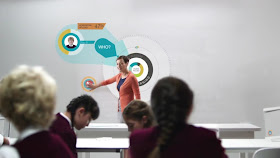 |
| Picture source: http://www.starscientific.com.au/ |
On the importance of science education
By Beat A. Schwendimann
Science education (leading towards scientific literacy) is of central importance for a modern democratic society. There are several ways to argue for the importance of science education: 1) Civic-democratic-utilitarian; 2) Vocational; 3) Aesthetic; and 4) Historic-cultural-social perspective.
The four perspectives use the theory of evolution as an example for learning a central scientific theory.
Civic-Democratic-Utilitarian perspective:
Scientific
literacy is required for a democracy. Democracies build on citizens being able
to make informed personal and community decisions about issues in which
scientific information plays a fundamental role, and they hence need a
knowledge of science as well as an understanding of scientific methodology (Duschl,
Schweingruber, & Shouse, 2007; Trefil, 2008). As John Dewey pointed out,
only a “learning society” (democracy) comprised of scientifically literate
citizens is adaptive enough to strive in the long run (Dewey, 1916).
Modern biology, in particular
genetics, is on the brink of giving us unprecedented power, from personalized
gene therapy to delaying the effects of aging. Society’s views if and how this
new knowledge should be used will be shaped by people’s understanding of their
evolutionary origins. Evolution is directly relevant to many policy decisions
and allows citizens to make informed decisions, for example: Infectious
diseases from tuberculosis to wheat rust are making a comeback as they evolve
resistance to our defenses; Antibiotic-resistant bacteria are a growing
problem; New deadly viruses might evolve the ability to jump species at any
time and spread through our globalized world causing a devastating pandemic.
Grasping the reality and seriousness
of such threats and making informed decisions requires citizens to understand
evolution. Citizens need to be able to make informed decisions on a wide
variety of evolution-related issues such as vaccinations, genetically-altered
food, gene therapy, cloning, genetic counseling, and stem cell research.
Understanding evolution allows us to understand the effects our changes to the
environments have on many species: For example, fishing policies that allow
fishermen to keep only large fish are leading to the evolution of smaller fish (Le
Page, 2008); rats are becoming resistant to poison; and urban songbirds change
their songs to counter noise pollution (Yong, 2008).
Education needs to empower and
motivate students to continue learning about current scientific findings after
they leave school. Situating evolution ideas in realistic contexts can make
ideas meaningful and applicable. Only through lifelong continuous learning can
we make evidence-based informed decisions, which is fostered by knowledge
integration, including situating ideas in realistic contexts.
Vocational
perspective:
Science
education has a dual goal: To produce scientifically literate citizens and to
produce scientifically proficient scientists (Duschl et al., 2007). For some
students, careers depending on biology will become a lifelong vocation. Nations
depend on the technical and scientific abilities of their citizens for their
economic competitiveness and national needs. Professions in biotechnology, pharmaceutics,
healthcare, and agriculture require a thorough understanding of genetics and
evolution. The ideas of evolution are of increasing importance in a wide
variety of research fields, for example evolutionary developmental biology,
evolutionary psychology, evolutionary engineering, evolutionary anthropology,
evolutionary economics, evolutionary computation, evolutionary ecology,
evolutionary medicine, evolutionary microbiology, evolutionary philosophy,
evolutionary analysis in law, paleontology, exobiology, climate change, and
even evolutionary religious studies.
Aesthetic
perspective:
Understanding
evolution means understanding the changes in organisms over time, both on a
macroscopic and a genetic level. Understanding evolution on multiple levels
allows us to connect current forms and events in nature to preceding processes.
The world looks different depending on whether you view humans as the perfect
finished product or as an imperfect animal thrown up by a cruel evolutionary
process. Understanding evolution allows people to see the current world in a
historic context and understand the mechanisms that lead to current forms.
Understanding evolution allows people to have a historic perspective on changes
in the world. It helps to understand the origins of human behavior and human
society structures by looking at them as adaptations to certain environments (Wilson,
2005). Understanding evolution can enhance our personal view of the world, for
example our appreciation of the complex beauty of nature. Catley (2006) notes that “[t]he sense of humility
gained through an appreciation of the kinship of all life is a vitally
important component in nurturing a stewardship ethic for a planet moving ever
deeper toward ecological collapse… [which could] have momentous reverberations
for future generations” (p. 781). Evolution and genetics ideas are frequently
used in popular books and movies. Many books refer to evolutionary theory to
explain a wide range of phenomena, from obesity (D'Adamo, D'Adamo, & Whitney,
1996), violent behavior (Brody, 1998; Wilson, 2000), disease control (Goode,
2000), to changing perceptions of race (Shane, 1999; Wolpoff & Caspari,
1997).
Historic-cultural-social
perspective:
Evolution
represents a major cultural achievement and a historic milestone in culturally
understanding. Evolution fundamentally changed the way we see our world and
ourselves. Understanding the origins and cultural impacts of evolution is an
important aspect of being scientifically literate. Learning about evolution is
closely connected to the history of science, nature of science, and
epistemology. Teaching biology without evolution is the equivalent of teaching
physics without the theory of gravity, or teaching about diseases without germ
theory.







